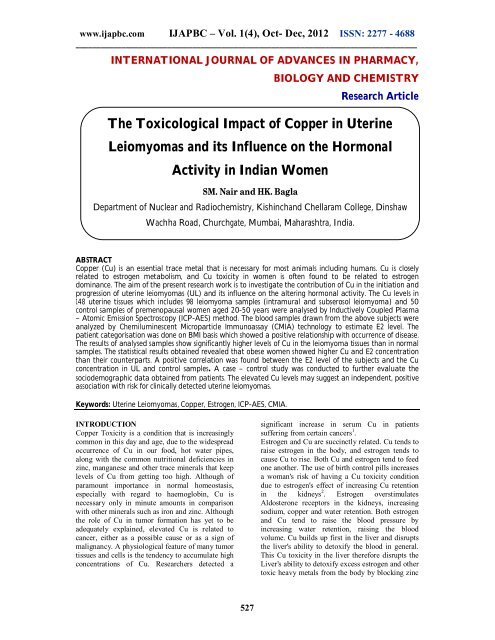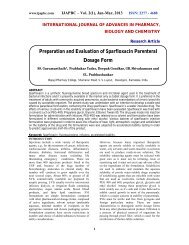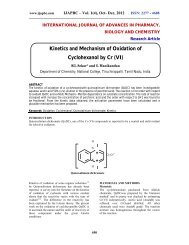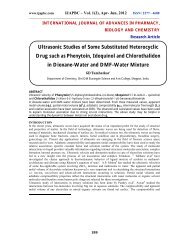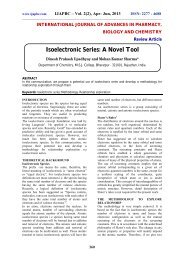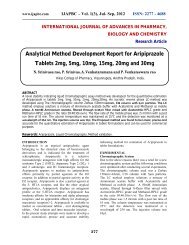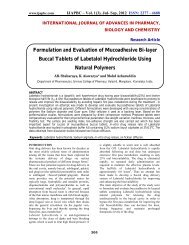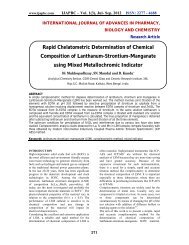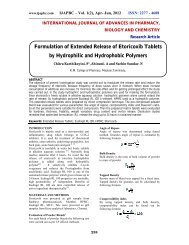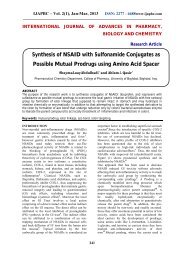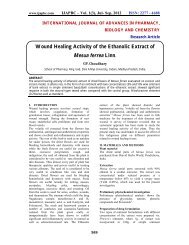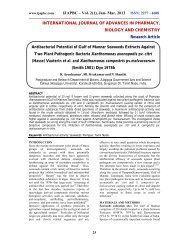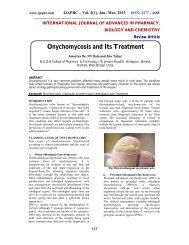The Toxicological Impact of Copper in Uterine Leiomyomas ... - ijapbc
The Toxicological Impact of Copper in Uterine Leiomyomas ... - ijapbc
The Toxicological Impact of Copper in Uterine Leiomyomas ... - ijapbc
Create successful ePaper yourself
Turn your PDF publications into a flip-book with our unique Google optimized e-Paper software.
www.<strong>ijapbc</strong>.com IJAPBC – Vol. 1(4), Oct- Dec, 2012 ISSN: 2277 - 4688<br />
__________________________________________________________________________________<br />
INTERNATIONAL JOURNAL OF ADVANCES IN PHARMACY,<br />
BIOLOGY AND CHEMISTRY<br />
Research Article<br />
<strong>The</strong> <strong>Toxicological</strong> <strong>Impact</strong> <strong>of</strong> <strong>Copper</strong> <strong>in</strong> Uter<strong>in</strong>e<br />
<strong>Leiomyomas</strong> and its Influence on the Hormonal<br />
Activity <strong>in</strong> Indian Women<br />
SM. Nair and HK. Bagla<br />
Department <strong>of</strong> Nuclear and Radiochemistry, Kish<strong>in</strong>chand Chellaram College, D<strong>in</strong>shaw<br />
Wachha Road, Churchgate, Mumbai, Maharashtra, India.<br />
ABSTRACT<br />
<strong>Copper</strong> (Cu) is an essential trace metal that is necessary for most animals <strong>in</strong>clud<strong>in</strong>g humans. Cu is closely<br />
related to estrogen metabolism, and Cu toxicity <strong>in</strong> women is <strong>of</strong>ten found to be related to estrogen<br />
dom<strong>in</strong>ance. <strong>The</strong> aim <strong>of</strong> the present research work is to <strong>in</strong>vestigate the contribution <strong>of</strong> Cu <strong>in</strong> the <strong>in</strong>itiation and<br />
progression <strong>of</strong> uter<strong>in</strong>e leiomyomas (UL) and its <strong>in</strong>fluence on the alter<strong>in</strong>g hormonal activity. <strong>The</strong> Cu levels <strong>in</strong><br />
148 uter<strong>in</strong>e tissues which <strong>in</strong>cludes 98 leiomyoma samples (<strong>in</strong>tramural and subserosol leiomyoma) and 50<br />
control samples <strong>of</strong> premenopausal women aged 20-50 years were analysed by Inductively Coupled Plasma<br />
– Atomic Emission Spectroscopy (ICP-AES) method. <strong>The</strong> blood samples drawn from the above subjects were<br />
analyzed by Chemilum<strong>in</strong>escent Microparticle Immunoassay (CMIA) technology to estimate E2 level. <strong>The</strong><br />
patient categorisation was done on BMI basis which showed a positive relationship with occurrence <strong>of</strong> disease.<br />
<strong>The</strong> results <strong>of</strong> analysed samples show significantly higher levels <strong>of</strong> Cu <strong>in</strong> the leiomyoma tissues than <strong>in</strong> normal<br />
samples. <strong>The</strong> statistical results obta<strong>in</strong>ed revealed that obese women showed higher Cu and E2 concentration<br />
than their counterparts. A positive correlation was found between the E2 level <strong>of</strong> the subjects and the Cu<br />
concentration <strong>in</strong> UL and control samples. A case – control study was conducted to further evaluate the<br />
sociodemographic data obta<strong>in</strong>ed from patients. <strong>The</strong> elevated Cu levels may suggest an <strong>in</strong>dependent, positive<br />
association with risk for cl<strong>in</strong>ically detected uter<strong>in</strong>e leiomyomas.<br />
Keywords: Uter<strong>in</strong>e <strong>Leiomyomas</strong>, <strong>Copper</strong>, Estrogen, ICP-AES, CMIA.<br />
INTRODUCTION<br />
<strong>Copper</strong> Toxicity is a condition that is <strong>in</strong>creas<strong>in</strong>gly<br />
common <strong>in</strong> this day and age, due to the widespread<br />
occurrence <strong>of</strong> Cu <strong>in</strong> our food, hot water pipes,<br />
along with the common nutritional deficiencies <strong>in</strong><br />
z<strong>in</strong>c, manganese and other trace m<strong>in</strong>erals that keep<br />
levels <strong>of</strong> Cu from gett<strong>in</strong>g too high. Although <strong>of</strong><br />
paramount importance <strong>in</strong> normal homeostasis,<br />
especially with regard to haemoglob<strong>in</strong>, Cu is<br />
necessary only <strong>in</strong> m<strong>in</strong>ute amounts <strong>in</strong> comparison<br />
with other m<strong>in</strong>erals such as iron and z<strong>in</strong>c. Although<br />
the role <strong>of</strong> Cu <strong>in</strong> tumor formation has yet to be<br />
adequately expla<strong>in</strong>ed, elevated Cu is related to<br />
cancer, either as a possible cause or as a sign <strong>of</strong><br />
malignancy. A physiological feature <strong>of</strong> many tumor<br />
tissues and cells is the tendency to accumulate high<br />
concentrations <strong>of</strong> Cu. Researchers detected a<br />
significant <strong>in</strong>crease <strong>in</strong> serum Cu <strong>in</strong> patients<br />
suffer<strong>in</strong>g from certa<strong>in</strong> cancers 1 .<br />
Estrogen and Cu are succ<strong>in</strong>ctly related. Cu tends to<br />
raise estrogen <strong>in</strong> the body, and estrogen tends to<br />
cause Cu to rise. Both Cu and estrogen tend to feed<br />
one another. <strong>The</strong> use <strong>of</strong> birth control pills <strong>in</strong>creases<br />
a woman's risk <strong>of</strong> hav<strong>in</strong>g a Cu toxicity condition<br />
due to estrogen's effect <strong>of</strong> <strong>in</strong>creas<strong>in</strong>g Cu retention<br />
<strong>in</strong> the kidneys 2 . Estrogen overstimulates<br />
Aldosterone receptors <strong>in</strong> the kidneys, <strong>in</strong>creas<strong>in</strong>g<br />
sodium, copper and water retention. Both estrogen<br />
and Cu tend to raise the blood pressure by<br />
<strong>in</strong>creas<strong>in</strong>g water retention, rais<strong>in</strong>g the blood<br />
volume. Cu builds up first <strong>in</strong> the liver and disrupts<br />
the liver's ability to detoxify the blood <strong>in</strong> general.<br />
This Cu toxicity <strong>in</strong> the liver therefore disrupts the<br />
Liver's ability to detoxify excess estrogen and other<br />
toxic heavy metals from the body by block<strong>in</strong>g z<strong>in</strong>c<br />
527
www.<strong>ijapbc</strong>.com IJAPBC – Vol. 1(4), Oct- Dec, 2012 ISSN: 2277 - 4688<br />
__________________________________________________________________________________<br />
<strong>in</strong> the b<strong>in</strong>d<strong>in</strong>g sites <strong>of</strong> metallothione<strong>in</strong> and other<br />
z<strong>in</strong>c dependent Liver enzymes.<br />
Other sources <strong>of</strong> chemicals which mimic estrogen,<br />
known as xenoestrogens, may also <strong>in</strong>crease the<br />
retention <strong>of</strong> Cu. <strong>The</strong>se <strong>in</strong>clude pesticides, Volatile<br />
Organic Compounds (VOC's), growth hormones<br />
used on animals, and all petrochemical waste<br />
products used <strong>in</strong> the manufactur<strong>in</strong>g <strong>of</strong> plastic,<br />
gasol<strong>in</strong>e and other petrochemical derivatives. One<br />
<strong>of</strong> the effects <strong>of</strong> Xenoestrogens is to reduce the<br />
excretion rate <strong>of</strong> Cu from the body. All estrogens<br />
cause Cu accumulation, xenoestrogens look like<br />
estrogens and hence also cause Cu retention. This<br />
leads to very high Cu levels <strong>in</strong> the body. <strong>Copper</strong><br />
Intra Uter<strong>in</strong>e Devices (IUDs) also contribute to<br />
excess Cu <strong>in</strong> the body. <strong>Copper</strong> IUDs work by<br />
releas<strong>in</strong>g small but significant amount <strong>of</strong> Cu <strong>in</strong>to<br />
the uterus. This Cu enters <strong>in</strong>to the blood caus<strong>in</strong>g all<br />
sorts <strong>of</strong> problems. Consistently high levels <strong>of</strong> Cu<br />
have been found <strong>in</strong> many types <strong>of</strong> human cancers,<br />
<strong>in</strong>clud<strong>in</strong>g breast, prostate, colon, lung and bra<strong>in</strong> 3,4 .<br />
<strong>The</strong>re are long term consequences <strong>of</strong> both Cu<br />
toxicity and excess estrogen. Estrogenic steroids<br />
have been shown to <strong>in</strong>crease Ceruloplasm<strong>in</strong> which<br />
is a Cu carry<strong>in</strong>g prote<strong>in</strong> <strong>in</strong> the blood <strong>of</strong> women<br />
tak<strong>in</strong>g oral contraceptives 5 . Side effects <strong>of</strong> these<br />
elevated Cu levels are common, with hypertension<br />
be<strong>in</strong>g the most frequent manifestation. Research by<br />
Horwitt and his co-workers 6 revealed the rise <strong>in</strong><br />
Ceruloplasm<strong>in</strong> and blood pressure exhibited by oral<br />
contraceptive users is directly related to the<br />
potency <strong>of</strong> the estrogen conta<strong>in</strong>ed <strong>in</strong> the<br />
contraceptive.<br />
Recent results obta<strong>in</strong>ed <strong>in</strong>dicate that trace levels <strong>of</strong><br />
Cu enhances the biological damage caused by O 7 2 .<br />
Accumulation <strong>of</strong> Cu traces <strong>in</strong> a given organ may<br />
cause <strong>in</strong>tracellular damage, ultimately express<strong>in</strong>g<br />
itself <strong>in</strong> cancerous lesions. In order to be able to<br />
shed light on the role <strong>of</strong> Cu <strong>in</strong> the progression <strong>of</strong><br />
UL which is a benign tumour <strong>of</strong> the uterus, it was<br />
sought to <strong>in</strong>vestigate its association <strong>in</strong> the<br />
formation <strong>of</strong> the tumour. It is critical to identify the<br />
roles <strong>of</strong> the potentially carc<strong>in</strong>ogenic metals <strong>in</strong> the<br />
etiology <strong>of</strong> UL, s<strong>in</strong>ce it rema<strong>in</strong>s the lead<strong>in</strong>g cause<br />
<strong>of</strong> hysterectomy (removal <strong>of</strong> the entire uterus) for<br />
women.<br />
<strong>The</strong> current paper aims at <strong>in</strong>vestigat<strong>in</strong>g the<br />
contribution <strong>of</strong> Cu <strong>in</strong> the <strong>in</strong>itiation and progression<br />
<strong>of</strong> UL and its possible association with hormonal<br />
alterations. Given the relation between Cu and<br />
estrogen, we hypothesized that Cu would be<br />
positively associated with an <strong>in</strong>creased odds <strong>of</strong> UL.<br />
MATERIALS AND METHODS<br />
Study population, cases and controls<br />
<strong>The</strong> study population consisted <strong>of</strong> premenopausal<br />
women under the care <strong>of</strong> gynaecologists at Beams<br />
Fibroid centre, Bandra. All the uter<strong>in</strong>e tissue<br />
samples were collected dur<strong>in</strong>g the period <strong>of</strong> June<br />
2009 till April 2010. Out <strong>of</strong> 250 patients a total <strong>of</strong><br />
148 (59%) were eligible for the research study, 98<br />
(66%) be<strong>in</strong>g leiomyoma samples and 50 (34%)<br />
control samples.<br />
Cases were first diagnosed with UL on the basis <strong>of</strong><br />
symptoms or abnormal pelvic exam<strong>in</strong>ation or by<br />
MRI scan. <strong>The</strong> patients considered were <strong>of</strong> 20-40<br />
years <strong>of</strong> age who were undergo<strong>in</strong>g Myomectomy<br />
for removal <strong>of</strong> fibroids. In order to focus on a<br />
population most likely to develop uter<strong>in</strong>e<br />
leiomyoma, postmenopausal women were<br />
excluded. Patients were considered to be<br />
postmenopausal if the date <strong>of</strong> the last menstrual<br />
period was more than six months and the records<br />
did not mention any situations or conditions that<br />
<strong>in</strong>duce suppression <strong>of</strong> menses. <strong>The</strong> other category<br />
<strong>of</strong> patients excluded were those who were pregnant,<br />
suffer<strong>in</strong>g from diseases like diabetes, hypertension,<br />
thyroid, etc. <strong>The</strong> women who had uter<strong>in</strong>e cancer<br />
were also excluded from the current study<br />
population. Controls were women <strong>of</strong> above age 40<br />
who was undergo<strong>in</strong>g hysterectomy for removal <strong>of</strong><br />
entire uterus. In addition these patient’s medical<br />
records had to have no mention <strong>of</strong> confirmed or<br />
suspected uter<strong>in</strong>e leiomyoma. <strong>The</strong> blood samples<br />
<strong>of</strong> all the above mentioned 148 subjects were<br />
collected and analysed for the estimation <strong>of</strong><br />
estradiol (E2).<br />
A structured questionnaire was collected regard<strong>in</strong>g<br />
the sociodemographic data like date <strong>of</strong> birth,<br />
marital status, medical history, menstrual patterns,<br />
use <strong>of</strong> oral contraceptives, family history <strong>of</strong><br />
hysterectomy due to UL, smok<strong>in</strong>g history, use <strong>of</strong><br />
cosmetics, height and body weight. A survey<br />
regard<strong>in</strong>g the diet <strong>of</strong> the patients was also<br />
conducted.<br />
<strong>The</strong> study protocol and the questionnaire were<br />
approved by the hospital and <strong>in</strong>stitution’s Ethics<br />
Committee. <strong>The</strong> patient consent form was obta<strong>in</strong>ed<br />
before collect<strong>in</strong>g the samples.<br />
Sample Collection and storage<br />
<strong>The</strong> uter<strong>in</strong>e tissue samples <strong>of</strong> controls and the UL<br />
were collected directly from the operation table <strong>of</strong><br />
Beams Fibroid centre, Mumbai, India. <strong>The</strong>se<br />
samples were stored <strong>in</strong> labelled, pre-treated and<br />
steam sterilized vials. <strong>The</strong>se vials were stored at -<br />
10 o C to -20 o C <strong>in</strong> a deep freeze. <strong>The</strong> tissue samples<br />
were dried by Lyophilisation method to remove<br />
moisture at KEM Hospital, Mumbai. <strong>The</strong> dried<br />
samples were ground to f<strong>in</strong>e powder us<strong>in</strong>g mortar<br />
and pestle. <strong>The</strong> powdered tissue samples were<br />
pretreated for analysis <strong>of</strong> Cu by us<strong>in</strong>g conc. HNO 3<br />
and conc. HClO 4 <strong>in</strong> 1:1 ratio. This solution was<br />
diluted upto 25 mL. <strong>The</strong> diluted solution <strong>of</strong><br />
samples was used for analysis. <strong>The</strong> concentration<br />
<strong>of</strong> Cu was determ<strong>in</strong>ed by us<strong>in</strong>g ICP-AES<br />
technique.<br />
<strong>The</strong> blood samples <strong>of</strong> controls and the leiomyoma<br />
patients were collected before the surgery. This was<br />
allowed to clot for 1 hour at room temperature. <strong>The</strong><br />
528
www.<strong>ijapbc</strong>.com IJAPBC – Vol. 1(4), Oct- Dec, 2012 ISSN: 2277 - 4688<br />
__________________________________________________________________________________<br />
clotted blood samples were centrifuged at 1000<br />
rpm for 10 m<strong>in</strong>s. <strong>The</strong> serum was removed us<strong>in</strong>g a<br />
micropipette and stored <strong>in</strong> sterilized and labeled<br />
vials at 5 o C. <strong>The</strong>se serum samples were subjected<br />
to E2 level detection. <strong>The</strong> Architect i2000 SR was<br />
used as a Chemilum<strong>in</strong>escent Microparticle<br />
Immunoassay (CMIA) technique for quantitative<br />
determ<strong>in</strong>ation <strong>of</strong> E2 level <strong>in</strong> the serum samples.<br />
Instrumentation<br />
Estimation <strong>of</strong> <strong>Copper</strong><br />
<strong>The</strong> concentration <strong>of</strong> <strong>Copper</strong> was determ<strong>in</strong>ed us<strong>in</strong>g<br />
ICP-AES technique. Among the vast analytical<br />
techniques available for analysis <strong>of</strong> metals,<br />
Inductively Coupled Plasma Atomic Emission<br />
Spectroscopy (ICP-AES) has enhanced advantage<br />
over other methods. It is an emission<br />
spectrophotometric technique, exploit<strong>in</strong>g the fact<br />
that excited electrons emit energy at a given<br />
wavelength as they return to ground state after<br />
excitation by high temperature Argon Plasma. It is<br />
a multielement analysis technique with highly<br />
effective multi-element detection source.<br />
Furthermore, it is beneficial for all types <strong>of</strong> watery<br />
and solid samples. <strong>The</strong> <strong>in</strong>strument has detection<br />
limits <strong>of</strong> elements up to ppb level. <strong>The</strong> <strong>in</strong>strument<br />
used for the current project was ARCOS Spectro<br />
(Germany) at IIT, Mumbai. Commercially<br />
available standards (MERCK multielemental<br />
standard) were used to calibrate the <strong>in</strong>strument. <strong>The</strong><br />
sample solutions were analysed <strong>in</strong> triplicate series.<br />
<strong>The</strong> operat<strong>in</strong>g parameters <strong>of</strong> ARCOS Spectro<br />
which were followed dur<strong>in</strong>g the experimental<br />
procedure have been given <strong>in</strong> Table 1.<br />
Estimation <strong>of</strong> estradiol (E2)<br />
<strong>The</strong> serum samples were analysed for the<br />
concentration <strong>of</strong> Estradiol (E2) at Microlabs,<br />
Mumbai. <strong>The</strong> ARCHITECT Estradiol assay is a<br />
delayed one step immunoassay used for the<br />
quantitative determ<strong>in</strong>ation <strong>of</strong> estradiol <strong>in</strong> human<br />
serum and plasma us<strong>in</strong>g Chemilum<strong>in</strong>escent<br />
Microparticle Immunoassay (CMIA) technology. It<br />
provides immunoassay test<strong>in</strong>g with <strong>in</strong>creased<br />
sample and reagent capacity. It has the best<br />
precision and accuracy <strong>of</strong> the assays evaluated for<br />
measurement <strong>of</strong> serum estradiol concentrations [8].<br />
<strong>The</strong> Instrument used for the estimation <strong>of</strong> serum<br />
estradiol <strong>in</strong> the present study was ARCHITECT<br />
i2000 SR (Abbott) at Microlabs Ltd, Mumbai.<br />
Patient Characterisation<br />
Epidemiologic studies show mixed results with<br />
respect to the association between BMI and uter<strong>in</strong>e<br />
leiomyoma 9,10 . In the present research work, the<br />
patients were categorized as Underweight, Normal,<br />
Overweight and Obese patients as illustrated <strong>in</strong><br />
Table 2. <strong>The</strong> calculated data suggests that higher<br />
BMI might be associated with the higher<br />
occurrence <strong>of</strong> the disease (P < 0.05).<br />
Statistical Analysis<br />
In the current research work statistical evaluation<br />
were carried out by us<strong>in</strong>g GraphPad Prism (version<br />
5). Data from the experiment were analysed us<strong>in</strong>g<br />
unpaired t-test. <strong>The</strong> groups categorised on the basis<br />
<strong>of</strong> BMI were <strong>in</strong>vestigated for its significance by<br />
Analysis <strong>of</strong> Variance. Statistical significance was<br />
set at 95% confidence level. Also Spearman<br />
correlation was used to compare the levels <strong>of</strong> Cu as<br />
well as E2 <strong>in</strong> controls and diseased samples. A<br />
model with all potential confounders <strong>in</strong>cluded was<br />
built by calculat<strong>in</strong>g the odds ratio (OR) and<br />
adjusted to 95% confidence <strong>in</strong>terval (CI) to<br />
evaluate the related risk factor <strong>of</strong> sociodemographic<br />
data and the <strong>in</strong>cidence <strong>of</strong> UL.<br />
RESULTS<br />
<strong>The</strong> Mean ±SD <strong>of</strong> the Cu and E2 concentration <strong>in</strong><br />
the leiomyoma samples and control samples as per<br />
the BMI categorisation have been illustrated <strong>in</strong><br />
Table 3 and Table 4 respectively.<br />
<strong>The</strong> total mean concentration <strong>of</strong> Cu observed <strong>in</strong><br />
control samples which <strong>in</strong>clude Underweight,<br />
Normal, Overweight and Obese women were 1.83<br />
± 0.87. <strong>The</strong> mean concentration <strong>of</strong> the leiomyoma<br />
samples which comprises <strong>of</strong> both <strong>in</strong>tramural<br />
leiomyoma and subserosol leiomyoma samples <strong>of</strong><br />
all the four categories <strong>of</strong> women were 6.29 ± 2.37.<br />
It has been observed from the results that the Cu<br />
concentration was significantly higher <strong>in</strong> UL<br />
samples than <strong>in</strong> the controls.<br />
<strong>The</strong> concentration <strong>of</strong> Cu (Mean ± SD) when<br />
calculated <strong>in</strong>dividually for <strong>in</strong>tramural and<br />
subserosol leiomyoma samples showed that the<br />
average concentration <strong>of</strong> Cu <strong>in</strong> subserosol<br />
leiomyoma (8.20 ± 1.07) was much higher as<br />
compared to <strong>in</strong>tramural leiomyoma (4.13 ± 1.36)<br />
samples. <strong>The</strong> result reveals that the average<br />
concentration <strong>of</strong> Cu <strong>in</strong> the diseased tissue was<br />
higher (P < 0.05) than the control samples. <strong>The</strong> Cu<br />
concentration <strong>in</strong> the leiomyoma samples was found<br />
to be <strong>in</strong> the order <strong>of</strong> Underweight (5.07 ± 2.27) <<br />
Normal (5.68 ± 2.24) < Overweight (6.28 ± 2.24) <<br />
Obese (7.89 ± 1.84).<br />
<strong>The</strong> Mean ± SD calculated for the E2 levels <strong>in</strong> the<br />
blood samples <strong>of</strong> the women revealed that the<br />
average E2 concentration <strong>in</strong> controls were <strong>of</strong> the<br />
order <strong>of</strong> Underweight < Normal < Overweight ><br />
Obese. <strong>The</strong> total mean concentration <strong>of</strong> E2 levels <strong>in</strong><br />
the controls <strong>of</strong> all the four categories was 193.82 ±<br />
61.57. <strong>The</strong> average E2 levels <strong>in</strong> the leiomyoma<br />
patients which <strong>in</strong>cludes women with <strong>in</strong>tramural and<br />
subserosol leiomyomas was found to be 543.68 ±<br />
127.55. When calculated <strong>in</strong>dividually, the average<br />
concentration <strong>of</strong> E2 <strong>in</strong> <strong>in</strong>tramural leiomyoma<br />
patients and subserosol leiomyoma patients was<br />
429.56 ± 71.88 and 644.63 ± 65.17 respectively.<br />
<strong>The</strong> above mentioned results show an <strong>in</strong>creased<br />
level <strong>of</strong> E2 <strong>in</strong> leiomyoma patients than <strong>in</strong> controls.<br />
<strong>The</strong> results portray an <strong>in</strong>creased level <strong>of</strong> E2 <strong>in</strong><br />
529
www.<strong>ijapbc</strong>.com IJAPBC – Vol. 1(4), Oct- Dec, 2012 ISSN: 2277 - 4688<br />
__________________________________________________________________________________<br />
women with subserosol leiomyoma patients than <strong>in</strong><br />
<strong>in</strong>tramural leiomyoma patients. <strong>The</strong> results<br />
calculated showed that the E2 concentration <strong>in</strong> the<br />
leiomyoma patients were <strong>in</strong> the order <strong>of</strong><br />
Underweight (474.63 ± 101.66) < Normal (489.40<br />
± 126.66) < Overweight (569.68 ± 98.95) < Obese<br />
(633.03 ± 111.52).<br />
<strong>The</strong> Influence <strong>of</strong> BMI on the Cu levels and E2<br />
levels <strong>in</strong> control and leiomyoma patients<br />
(Intramural leiomyoma and subserosol leiomyoma)<br />
has been shown <strong>in</strong> Figure 1 and Figure 2<br />
respectively.<br />
F<strong>in</strong>ally Spearman correlation test showed a<br />
significant relationship between Cu concentration<br />
and E2 levels <strong>in</strong> women with UL (r = 0.984, P <<br />
0.0001) and controls (r = 0.866, P < 0.0001). Table<br />
5 illustrates the results <strong>of</strong> the correlation <strong>of</strong> Cu with<br />
E2 <strong>in</strong> Underweight, Normal, Overweight and<br />
Obese group <strong>of</strong> patients. <strong>The</strong> data shown is<br />
<strong>in</strong>dicative that the E2 level has positive correlation<br />
with the concentration <strong>of</strong> Cu. <strong>The</strong> data <strong>of</strong> the<br />
alter<strong>in</strong>g distributions <strong>of</strong> Cu concentration and E2<br />
concentration <strong>in</strong> normal and diseased tissues have<br />
been graphically represented <strong>in</strong> Figure 3, Figure 4<br />
and Figure 5. A positive correlation was observed<br />
between the Cu concentration and E2 level <strong>in</strong> the<br />
controls as well as cases with <strong>in</strong>tramural and<br />
subserosol leiomyomas.<br />
Table 6 demonstrates the association <strong>of</strong> UL with<br />
the sociodemographic characteristics obta<strong>in</strong>ed from<br />
the leiomyoma patients and controls. Accord<strong>in</strong>g to<br />
the sociodemographic survey it was observed that<br />
married women have a low risk factor <strong>of</strong> suffer<strong>in</strong>g<br />
from UL when compared to unmarried females<br />
(OR = 0.42. 95% CI = 0.17 - 1.06). It was observed<br />
that women with irregular menstrual pattern (84%)<br />
showed greater <strong>in</strong>cidences <strong>of</strong> UL than controls (OR<br />
=29.05. 95% CI = 11.40 - 73.98) and 53% <strong>of</strong> the<br />
cases had a history <strong>of</strong> maternal hysterectomy due to<br />
UL (OR = 4.52. 95% CI = 2.03- 10.04).<br />
From the diet survey report obta<strong>in</strong>ed from the<br />
subjects (Table 7), it was found that 71.4% <strong>of</strong> the<br />
patients were Vegetarians and had higher risk <strong>of</strong><br />
suffer<strong>in</strong>g from UL (OR = 4.07. 95% CI = 1.98 –<br />
8.37). 56 % <strong>of</strong> the cases used copper cookwares<br />
and were found to have an <strong>in</strong>creased risk factor<br />
when compared to controls (OR = 1.50. 95% CI =<br />
0.75- 2.97). Hence the results show that the source<br />
<strong>of</strong> Cu bioaccumulation <strong>in</strong> the tissues might be due<br />
to the higher <strong>in</strong>take <strong>of</strong> vegetarian diets and us<strong>in</strong>g<br />
copper cookwares.<br />
DISCUSSION<br />
Elevated Cu level produces a number <strong>of</strong> symptoms.<br />
<strong>The</strong> current environmental and social climate<br />
suggests that the <strong>in</strong>cidences <strong>of</strong> Cu precipitated<br />
disease are on rise. Cu ions are a general stimulant<br />
<strong>of</strong> nervous tissue, as well as <strong>of</strong> most tissues <strong>of</strong> the<br />
body. Cu imbalance impairs the immune<br />
system. Elevated Cu on a hair m<strong>in</strong>eral analysis is<br />
<strong>of</strong>ten related to a tendency for <strong>in</strong>fections and even<br />
cancer. It has been discovered that Cu is the cause<br />
<strong>of</strong> Histapenia, a schizophrenia-like disorder<br />
characterized by high serum copper and low serum<br />
histam<strong>in</strong>e levels 11 . <strong>The</strong> current study provides data<br />
on the alter<strong>in</strong>g Cu levels <strong>in</strong> human uter<strong>in</strong>e tissue<br />
samples. It was observed that <strong>in</strong> the diseased tissue,<br />
which <strong>in</strong>cludes <strong>in</strong>tramural and subserosol<br />
leiomyoma samples, the mean concentration <strong>of</strong> Cu<br />
was significantly higher as compared to the control<br />
tissues.<br />
Obesity and overweight are major contributors to<br />
the global burden <strong>of</strong> chronic diseases and are<br />
associated with diabetes, hyper-<strong>in</strong>sul<strong>in</strong>emia, <strong>in</strong>sul<strong>in</strong><br />
resistance, coronary heart disease, high blood<br />
pressure, stroke, gout, liver disease, asthma and<br />
pulmonary problems, gall bladder disease, kidney<br />
disease, reproductive problems, osteoarthritis, and<br />
some forms <strong>of</strong> cancer 12,13 . High fat volume is<br />
associated with elevated levels <strong>of</strong> serum estrogen<br />
14 . It was observed <strong>in</strong> the current research paper<br />
that there was an <strong>in</strong>creased UL risk among women<br />
<strong>in</strong> the upper quartile <strong>of</strong> the BMI. Overall f<strong>in</strong>d<strong>in</strong>gs<br />
for BMI and risk <strong>of</strong> UL showed an <strong>in</strong>verse J-<br />
shaped pattern for all categories <strong>of</strong> BMI above 18.4<br />
kg/m 2 and a peak <strong>in</strong>cidence associated with a BMI<br />
category <strong>of</strong> more than 25 kg/m 2 . <strong>The</strong>se results are<br />
consistent with previous studies that found a<br />
positive association <strong>of</strong> UL with the higher BMI 15 .<br />
<strong>The</strong> levels <strong>of</strong> estrogen and Cu have a direct<br />
relationship. This is one reason many women are<br />
estrogen dom<strong>in</strong>ant. This imbalance is related to<br />
tumour formation because estrogen is a potent<br />
carc<strong>in</strong>ogen. <strong>The</strong> present study has exam<strong>in</strong>ed the<br />
association <strong>of</strong> Cu and its correlation with the<br />
<strong>in</strong>creased E2 level <strong>in</strong> the patients, f<strong>in</strong>d<strong>in</strong>g that there<br />
was a positive correlation between the two. <strong>The</strong><br />
present study <strong>in</strong>dicates possible association <strong>of</strong> Cu<br />
and its <strong>in</strong>cidence <strong>in</strong> the formation <strong>of</strong> UL. As UL<br />
have elevated estrogen levels 16 , and as Cu also<br />
<strong>in</strong>creases estrogen levels, we hypothesised that the<br />
<strong>in</strong>creased concentration <strong>of</strong> Cu <strong>in</strong> the diseased<br />
samples might be a reason for the leiomyoma<br />
formation. <strong>The</strong> small difference <strong>in</strong> the<br />
concentration <strong>of</strong> Cu can alter the hormonal level<br />
which <strong>in</strong>itiates the leiomyoma formation. <strong>The</strong><br />
result shows that the concentration <strong>of</strong> Cu is<br />
significantly higher <strong>in</strong> subserosol leiomyomas as<br />
compared to <strong>in</strong>tramural leiomyomas. This might<br />
<strong>in</strong>dicate that women with higher level <strong>of</strong> tissue Cu<br />
deposition are more prone to suffer from subserosol<br />
leiomyomas.<br />
Foods high <strong>in</strong> Cu are nuts, liver, mushrooms,<br />
oysters, and wheat germ. Other sources <strong>of</strong> copper<br />
are copper cookware, dental materials, vitam<strong>in</strong><br />
pills, fungicides and pesticide residue on food.<br />
Deficiencies <strong>of</strong> manganese, iron, B-vitam<strong>in</strong>s and<br />
vitam<strong>in</strong> C can cause Cu to accumulate. In the<br />
current research paper, when a case – control study<br />
was conducted it was found that leiomyoma<br />
530
www.<strong>ijapbc</strong>.com IJAPBC – Vol. 1(4), Oct- Dec, 2012 ISSN: 2277 - 4688<br />
__________________________________________________________________________________<br />
patients were consum<strong>in</strong>g more vegetarian diets as<br />
compared to controls. Also, the percentage <strong>of</strong><br />
patients us<strong>in</strong>g copper cookwares was also higher.<br />
<strong>The</strong> above mentioned source is <strong>in</strong>dicative <strong>of</strong> higher<br />
Cu concentration <strong>in</strong> the cases when compared to<br />
controls. Women on oral contraceptives have<br />
considerably <strong>in</strong>creased serum copper<br />
concentrations 17 and accumulated more Cu, which<br />
curiously is likely to be beneficial <strong>in</strong> the event <strong>of</strong><br />
pregnancy. Release <strong>of</strong> Cu from <strong>in</strong>tra uter<strong>in</strong>e<br />
contraceptive devices conta<strong>in</strong><strong>in</strong>g Cu has been<br />
shown to be significant, amount<strong>in</strong>g to about 10 mg<br />
Cu per year 18 . In the present work, the survey<br />
conducted revealed a slight significant difference<br />
between patients us<strong>in</strong>g <strong>in</strong>tra uter<strong>in</strong>e devices and<br />
oral contraceptives than patients not us<strong>in</strong>g it.<br />
<strong>The</strong> <strong>in</strong>volvement <strong>of</strong> Cu ions <strong>in</strong> biological damage<br />
may be proved s<strong>in</strong>ce most <strong>of</strong> the Cu found <strong>in</strong><br />
tissues is specifically bound, compris<strong>in</strong>g an <strong>in</strong>tegral<br />
part <strong>of</strong> various enzymes. In the present study, we<br />
observed an <strong>in</strong>crease <strong>in</strong> the total tissue copper<br />
content which may represent a considerable<br />
<strong>in</strong>crease <strong>in</strong> the nonspecific complexed Cu that is<br />
responsible for the biological damage.<br />
Limitations to be considered for the present study<br />
as the sample size may have been too small to<br />
provide adequate statistical power to detect<br />
mean<strong>in</strong>gful differences between the values<br />
compared. <strong>The</strong> results cannot be extrapolated to<br />
general population as this was a hospital based<br />
study.<br />
CONCLUSION<br />
Although Cu is an essential trace m<strong>in</strong>eral, a serious<br />
health threat is posed by the excess <strong>in</strong>take <strong>of</strong> the<br />
metal. This study confirmed the existence <strong>of</strong> a<br />
substantially higher risk <strong>of</strong> UL <strong>in</strong> the presence <strong>of</strong><br />
the heavy metal Cu. <strong>The</strong> results may imply that Cu,<br />
by way <strong>of</strong> accumulation <strong>in</strong> the uterus and<br />
metalloestrogenic activity contribute to the<br />
generation <strong>of</strong> hormone-dependent UL. While<br />
exist<strong>in</strong>g data are very limited, it is encourag<strong>in</strong>g that<br />
Cu identified <strong>in</strong> this study is important <strong>in</strong><br />
dist<strong>in</strong>guish<strong>in</strong>g between normal and diseased<br />
tissues. <strong>The</strong> amount <strong>of</strong> Cu <strong>in</strong> UL is augmented<br />
when compared to controls specimens and it proves<br />
that the <strong>in</strong>cidences <strong>of</strong> elevated Cu act as a potential<br />
carc<strong>in</strong>ogen <strong>in</strong> the etiology <strong>of</strong> UL. Its <strong>in</strong>fluence <strong>in</strong><br />
uter<strong>in</strong>e tissue is very much evident <strong>in</strong> caus<strong>in</strong>g<br />
<strong>in</strong>tramural and subserosol leiomyomas. <strong>The</strong><br />
<strong>in</strong>terpretation <strong>of</strong> results could help to understand<br />
the potential role <strong>of</strong> Cu toxicity <strong>in</strong> elevat<strong>in</strong>g the<br />
levels <strong>of</strong> E2 <strong>in</strong> patients diagonised with UL. Also a<br />
significant relationship was found between<br />
<strong>in</strong>creased BMI and formation <strong>of</strong> UL. From the<br />
above mentioned studies, it provides evidence for a<br />
possible l<strong>in</strong>k between Cu and <strong>in</strong>cidence <strong>of</strong> UL, and<br />
identifies priority areas that should motivate further<br />
studies.<br />
ACKNOWLEDGEMENTS<br />
<strong>The</strong> present authors express s<strong>in</strong>cere thanks to Dr.<br />
Rakesh S<strong>in</strong>ha and Dr. Parul Shah, Beams Fibroid<br />
Centre for provid<strong>in</strong>g uter<strong>in</strong>e tissue samples and Ms<br />
V<strong>in</strong>ita Shetty, Indian Institute <strong>of</strong> Technology (IIT)<br />
Mumbai for technical assistance <strong>in</strong> the present<br />
research work. We express our gratitude to Dr.<br />
Shankar Kumar for help<strong>in</strong>g us with the<br />
lyophilization process. We s<strong>in</strong>cerely express our<br />
gratitude to Ms. Flavia Almeida, Head-<br />
Immunochemistry, Metropolis Healthcare Ltd for<br />
E2 analysis.<br />
Table 1: ICP-AES <strong>in</strong>strument characteristics<br />
and operat<strong>in</strong>g parameters<br />
Parameters<br />
RF Generator<br />
Power Required<br />
Flame<br />
Temperature<br />
Plasma<br />
Spectra Range<br />
Coolant Flow<br />
Auxillary Flow<br />
Nebulizer<br />
Sensitivity<br />
Sett<strong>in</strong>g<br />
1000 watts<br />
220±10 V<br />
11000 K<br />
Argon<br />
189-800 nm<br />
12 L/m<strong>in</strong><br />
1 L/m<strong>in</strong><br />
0.8L/m<strong>in</strong><br />
ppb level <strong>of</strong><br />
detection<br />
Table 2: Categorization <strong>of</strong> the samples on<br />
the basis <strong>of</strong> BMI criteria <strong>of</strong> the patients<br />
Category<br />
BMI Cases Controls<br />
(Kg/m 2 ) No. % No. %<br />
Underweight >18.4 22 22.44 12 24<br />
Normal 18.5 – 22.9 27 27.55 13 26<br />
Overweight 23 – 24.9 22 22.44 11 22<br />
Obese
www.<strong>ijapbc</strong>.com IJAPBC – Vol. 1(4), Oct- Dec, 2012 ISSN: 2277 - 4688<br />
__________________________________________________________________________________<br />
Table 3: <strong>The</strong> Concentration <strong>of</strong> Cu (Mean ±SD) <strong>of</strong> the<br />
samples on the basis <strong>of</strong> BMI criteria <strong>of</strong> the patients<br />
Category BMI(kg/m 2 )<br />
Leiomyoma Samples<br />
Controls<br />
Intramural Subserosol<br />
(n = 46) (n = 52)<br />
(n = 50)<br />
Underweight >18.4 3.00 ± 0.80 7.15 ± 0.88 0.98 ± 0.60<br />
Normal 18.5 – 22.9 3.51 ± 0.77 7.69 ± 0.63 1.21 ± 0.42<br />
Overweight 23 – 24.9 3.99 ± 0.78 8.19 ± 0.60 2.34 ± 0.45<br />
Obese < 25 5.95 ± 0.65 9.45 ± 0.39 2.73 ± 0.29<br />
Table 4: <strong>The</strong> Concentration <strong>of</strong> E2 (Mean ±SD) <strong>of</strong> the samples<br />
on the basis <strong>of</strong> BMI criteria <strong>of</strong> the patients<br />
Category BMI(kg/m 2 )<br />
Leiomyoma Samples<br />
Controls<br />
Intramural Subserosol<br />
(n = 50)<br />
(n = 46) (n = 52)<br />
Underweight >18.4 376.27 ± 12.59 573 ± 13.68 111.25± 4.69<br />
Normal 18.5 – 22.9 364.38 ± 40.07 605.5 ± 21.52 166.84 ± 29.19<br />
Overweight 23 – 24.9 471.10 ± 41.33 651.83± 33.15 258.27 ± 28.38<br />
Obese < 25 514.41± 22.17 727.93 ± 31.65 239 ± 11.42<br />
Patient Groups<br />
Controls<br />
Intramural leiomyoma<br />
Subserosol leiomyoma<br />
Table 5: Correlation coefficient (r) <strong>of</strong> Cu and E2<br />
on the basis <strong>of</strong> BMI criteria <strong>of</strong> the patients<br />
Underweight<br />
(< 18.4)<br />
r = 0.996<br />
P < 0.0001<br />
r = 0.993<br />
P < 0.0001<br />
r = 0.998<br />
P < 0.0001<br />
Normal<br />
(18.5 – 22.9)<br />
r = 0.994<br />
P < 0.0001<br />
r = 0.999<br />
P < 0.0001<br />
r = 0.997<br />
P < 0.0001<br />
Overweight<br />
(23 – 24.9)<br />
r = 0.998<br />
P < 0.0001<br />
r = 1.000<br />
P < 0.0001<br />
r = 0.998<br />
P < 0.0001<br />
Obese<br />
(> 25)<br />
r = 0.989<br />
P < 0.0001<br />
r = 1.000<br />
P < 0.0001<br />
r = 0.999<br />
P < 0.0001<br />
Table 6: Study characteristics <strong>of</strong> cases with UL and controls<br />
accord<strong>in</strong>g to the sociodemographic survey<br />
Sociodemographic Data<br />
Marital status<br />
Smok<strong>in</strong>g status<br />
Alcohol use<br />
Menstrual Irregularity<br />
Use <strong>of</strong> birth control pills<br />
Use <strong>of</strong> Cosmetics<br />
Maternal hysterectomy due to<br />
uter<strong>in</strong>e leiomyoma<br />
Inference<br />
Married<br />
Never<br />
married<br />
Yes<br />
No<br />
Yes<br />
No<br />
Yes<br />
No<br />
Yes<br />
No<br />
Yes<br />
No<br />
Yes<br />
No<br />
Cases (n = 98) Controls (n = 50) Odds Ratio<br />
No. % No. % (95% CI)<br />
71<br />
27<br />
24<br />
74<br />
29<br />
69<br />
83<br />
15<br />
40<br />
58<br />
50<br />
48<br />
52<br />
46<br />
72.4<br />
27.5<br />
24.4<br />
75.5<br />
29.5<br />
70.4<br />
84<br />
15.3<br />
40.8<br />
59.1<br />
51<br />
49<br />
53<br />
47<br />
43<br />
7<br />
14<br />
36<br />
21<br />
29<br />
8<br />
42<br />
25<br />
25<br />
26<br />
24<br />
10<br />
40<br />
86<br />
14<br />
28<br />
72<br />
42<br />
58<br />
16<br />
84<br />
50<br />
50<br />
52<br />
48<br />
20<br />
80<br />
0.42<br />
(0.17 - 1.06)<br />
0.83<br />
(0.38 - 1.80)<br />
0.58<br />
(0.28 - 1.18)<br />
29.05<br />
(11.40-73.98)<br />
0.68<br />
(0.34 - 1.36)<br />
0.96<br />
(0.48 - 1.90)<br />
4.52<br />
(2.03- 10.04)<br />
532
www.<strong>ijapbc</strong>.com IJAPBC – Vol. 1(4), Oct- Dec, 2012 ISSN: 2277 - 4688<br />
__________________________________________________________________________________<br />
Diet Survey<br />
Type <strong>of</strong> Diet<br />
Use copper cookwares<br />
Eat Chocolates frequently<br />
Use Tap Water<br />
Use Intra Uter<strong>in</strong>e Devices<br />
Use Oral Contraceptives<br />
Table 7: Study characteristics <strong>of</strong> cases with UL and<br />
controls accord<strong>in</strong>g to diet survey<br />
Inference<br />
Vegetarian<br />
Non Vegetarian<br />
Yes<br />
No<br />
Yes<br />
No<br />
Yes<br />
No<br />
Yes<br />
No<br />
Yes<br />
No<br />
Cases (n = 98) Controls (n = 50) Odds Ratio<br />
No. % No. % (95% CI)<br />
70 71.4 19 38 4.07<br />
28 28.5 31 31.6 (1.98 - 8.37)<br />
55 56.1 23 46 1.50<br />
43 43.8 27 27.5 (0.75- 2.97)<br />
83 84.6 36 72 2.15<br />
15 15.3 14 14.2 (0.94- 4.91)<br />
21 21.4 15 15.3 0.63<br />
77 78.5 35 35.7 (0.29- 1.37)<br />
45 45.9 20 40 1.27<br />
53 54 30 60 (0.63- 2.54)<br />
49 50 24 48 1.08<br />
49 50 26 52 (0.54- 2.14)<br />
BMI and Cu<br />
10<br />
Subserosol leiomyoma<br />
Cu Conc.(µg/g dry weight))<br />
8<br />
6<br />
4<br />
2<br />
0<br />
Intramural Leiomyoma<br />
Controls<br />
UW N OW O<br />
BMI<br />
Controls<br />
Intramural<br />
Subserosol<br />
Fig. 1: Influence <strong>of</strong> BMI on the concentration <strong>of</strong><br />
Cu <strong>in</strong> the leiomyoma and control samples<br />
BMI and E2<br />
800<br />
Subserosol leiomyoma<br />
E2 conc (pg/mL)<br />
600<br />
400<br />
200<br />
Intramural Leiomyoma<br />
Controls<br />
Controls<br />
Intramural<br />
Subserosol<br />
0<br />
UW N OW O<br />
BMI<br />
Fig. 2: Influence <strong>of</strong> BMI on the E2 levels <strong>in</strong><br />
the leiomyoma patients and controls<br />
533
www.<strong>ijapbc</strong>.com IJAPBC – Vol. 1(4), Oct- Dec, 2012 ISSN: 2277 - 4688<br />
__________________________________________________________________________________<br />
Correlation <strong>of</strong> Cu concentration with E2 level <strong>in</strong> Controls<br />
400<br />
E2 conc (pg/mL)<br />
300<br />
200<br />
100<br />
0<br />
0 1 2 3 4<br />
Cu conc (µg/g dry weight)<br />
Fig. 3: Correlation <strong>of</strong> Cu concentration with E2 levels <strong>in</strong> control<br />
Correlation <strong>of</strong> Cu concentration with E2 level <strong>in</strong> Intramural leiomyoma patients<br />
600<br />
E2 conc (pg/mL)<br />
500<br />
400<br />
300<br />
200<br />
2 4 6 8<br />
Cu conc (µg/g dry weight)<br />
Fig. 4: Correlation <strong>of</strong> Cu concentration with E2<br />
levels <strong>in</strong> Intramural leiomyoma Patients<br />
Correlation <strong>of</strong> Cu concentration with E2 level <strong>in</strong> Subserosol leiomyoma patients<br />
900<br />
800<br />
E2 conc (pg/mL)<br />
700<br />
600<br />
500<br />
400<br />
6 8 10 12 14<br />
Cu conc (µg/g dry weight)<br />
Fig. 5: Correlation <strong>of</strong> Cu concentration with E2 levels <strong>in</strong><br />
Subserosol leiomyoma Patients<br />
REFERENCES<br />
1. AFM Nazmus Sadat. Serum Trace<br />
Elements and Immunoglobul<strong>in</strong> Pr<strong>of</strong>ile <strong>in</strong><br />
Lung Cancer Patients, <strong>The</strong> Journal <strong>of</strong><br />
Applied Research 2008;8(1) 24-33.<br />
2. http://www.holistic-backrelief.com/copper-toxicity.html.<br />
3. Sharma K, Mittal DK, Kesarwani RC,<br />
Kamboj VP and Chowdhery. Diagnostic<br />
and prognostic significance <strong>of</strong> serum and<br />
tissue trace elements <strong>in</strong> breast malignancy.<br />
Indian J Med Sci. 1994; 48:227-232.<br />
4. Margalioth EJ, Schenker JG and Chevion<br />
M. <strong>Copper</strong> and z<strong>in</strong>c levels <strong>in</strong> normal and<br />
534
www.<strong>ijapbc</strong>.com IJAPBC – Vol. 1(4), Oct- Dec, 2012 ISSN: 2277 - 4688<br />
__________________________________________________________________________________<br />
malignant tissues. Cancer. 1983;52:868-<br />
872.<br />
5. Rubenfeld Y, Maor Y and Modai D.<br />
Progressive rise <strong>in</strong> serum copper levels <strong>in</strong><br />
women tak<strong>in</strong>g oral contraceptives: a<br />
potential hazard?, Fertil Steril.<br />
1971;32:599-601.<br />
6. Horwitt MK, Harvey CC and Dahm CH<br />
Jr. Relationship between levels <strong>of</strong> blood<br />
lipids, vitam<strong>in</strong>s C, A and E., serum copper<br />
compounds, and ur<strong>in</strong>ary excretions <strong>of</strong><br />
tryptophan metabolites <strong>in</strong> women tak<strong>in</strong>g<br />
oral contraceptive therapy. Am J Cl<strong>in</strong><br />
Nutr. 1975;28:403-12.<br />
7. Samuni A, Chevion M and Czapski G.<br />
Unusual <strong>Copper</strong> <strong>in</strong>duced sensitization <strong>of</strong><br />
the biological damage due to superoxide<br />
radical. J boil chem. 1981;256:12632-<br />
12635.<br />
8. David TY, William EO, Carol SR, Hui X<br />
and William LR. Performance<br />
Characteristics <strong>of</strong> Eight Estradiol<br />
Immunoassays. Am J Cl<strong>in</strong> Path.<br />
2004;122:332-337.<br />
9. Ross RK, Pike MC and Vessey MP. Risk<br />
factors for uter<strong>in</strong>e fibroids: reduced risk<br />
associated with oral contraceptives. Br<br />
Med J Cl<strong>in</strong> Res Ed. 1986;293:359–362.<br />
10. Parazz<strong>in</strong>i F, Negri E and La Vecchia C.<br />
Reproductive factors and risk <strong>of</strong> uter<strong>in</strong>e<br />
fibroids, Epidemiology. 1996;7:440–442.<br />
11. Carl CP and Richard M. Excess <strong>Copper</strong> as<br />
a Factor <strong>in</strong> Human Diseases. Journal <strong>of</strong><br />
Orthomolecular Medic<strong>in</strong>e. 1987;2(3):171.<br />
12. Coll<strong>in</strong>s S. Overview <strong>of</strong> cl<strong>in</strong>ical<br />
perspectives and mechanisms <strong>of</strong> obesity.<br />
Birth Defects. Res A Cl<strong>in</strong> Mol Teratol.<br />
2005;73:470-471.<br />
13. Mokdad AH, Ford ES and Bowman BA.<br />
Prevalence <strong>of</strong> obesity, diabetes, and<br />
obesity-related health risk factors, JAMA.<br />
2003;289:76-79.<br />
14. James JD, Kelly W, Karen A, Bernard F,<br />
Lei Xu and Eleftherios PM. Obesity,<br />
Tamoxifen Use, and Outcomes <strong>in</strong> Women<br />
With Estrogen Receptor–Positive Early-<br />
Stage Breast Cancer. Journal <strong>of</strong> the<br />
National Cancer Institute.<br />
2003;94(19):1467-76.<br />
15. Samadi AR, Lee NC and Flanders WD.<br />
Risk factors for self-reported uter<strong>in</strong>e<br />
fibroids: a case-control study. Am J Public<br />
Health. 1996;86:858 – 62.<br />
16. http://www.fibroid101.com/<br />
17. Carruthers ME, Hobbs CB and Warren<br />
RL. Raised serum copper and<br />
eruloplasm<strong>in</strong> levels <strong>in</strong> subjects tak<strong>in</strong>g oral<br />
contraceptives. J Cl<strong>in</strong> Path.1966;19:498-<br />
501.<br />
18. Hagenfeldt K. Intrauter<strong>in</strong>e contraception<br />
with the copper-T device. Effect on trace<br />
elements <strong>in</strong> the endometrium, cervical<br />
mucous and plasma, Contraception.<br />
1972;6:37-54.<br />
535


